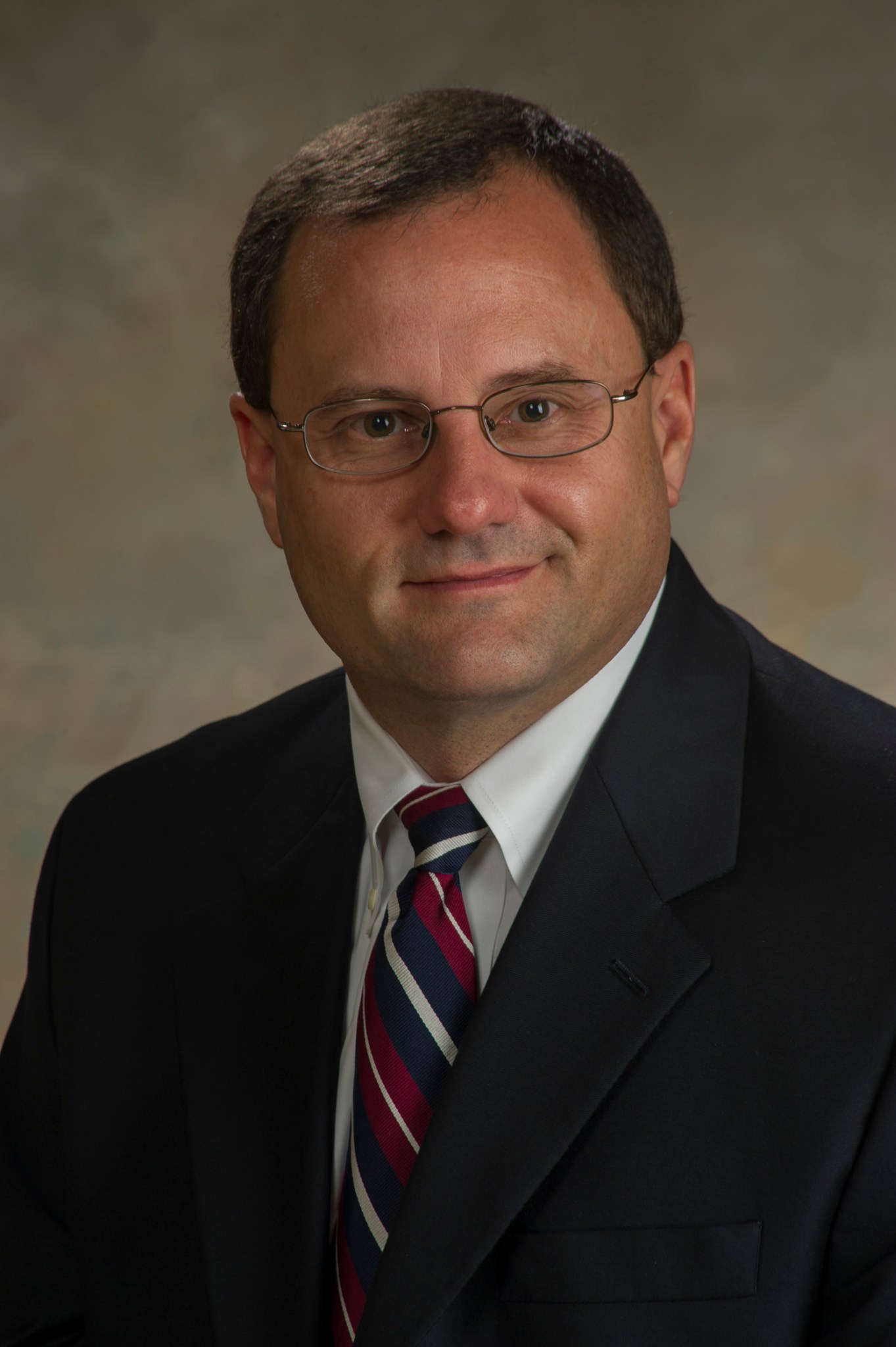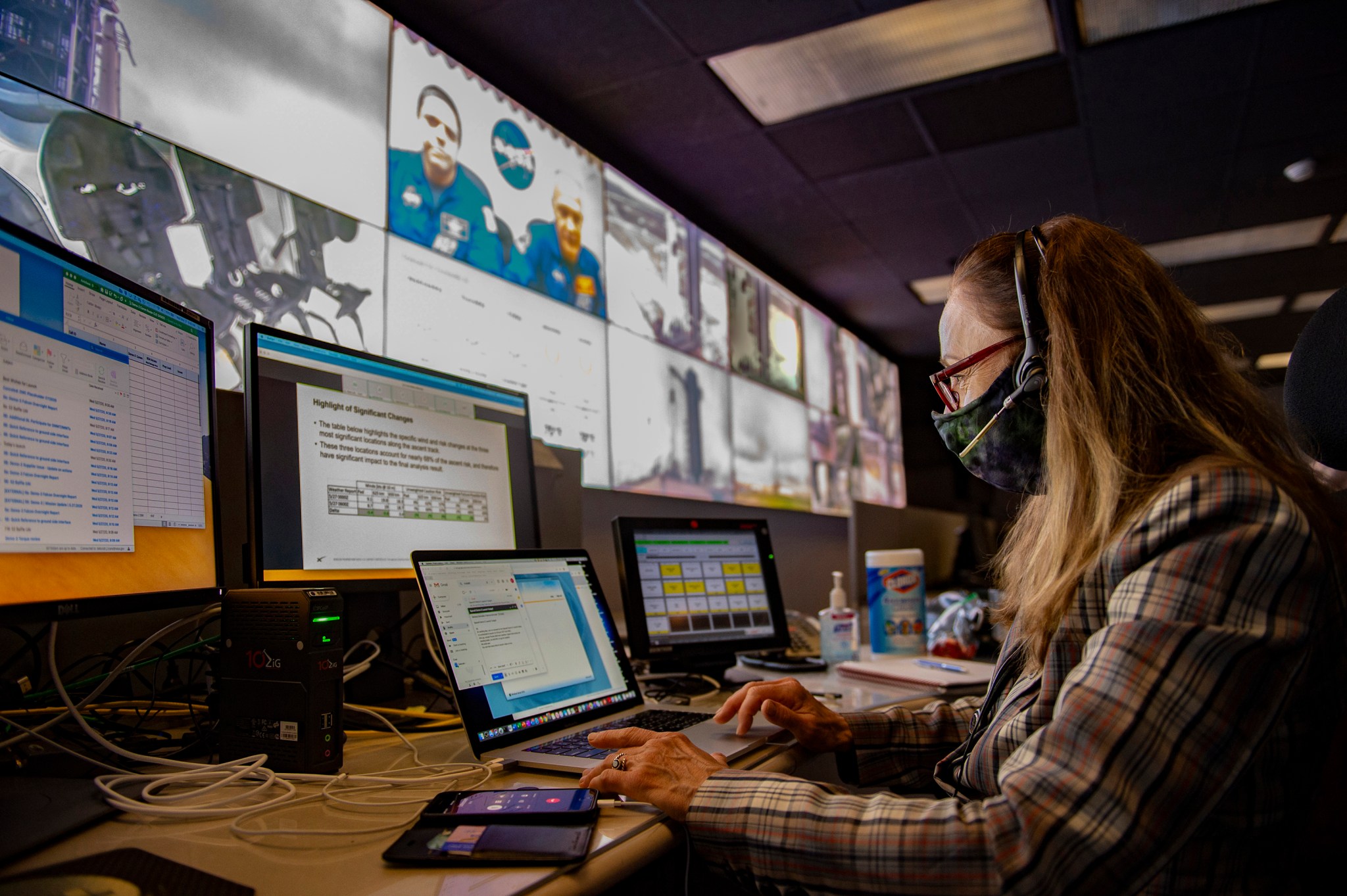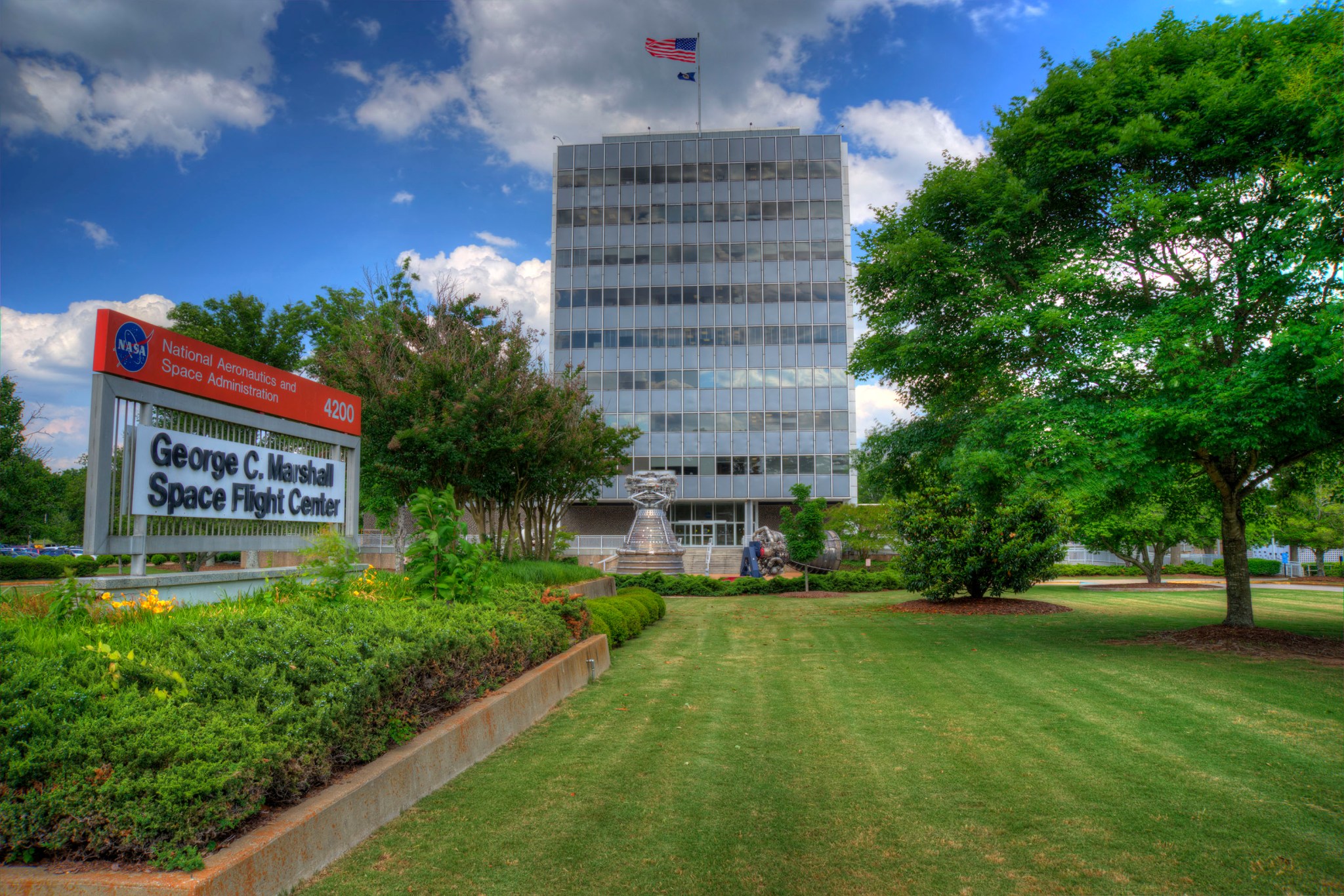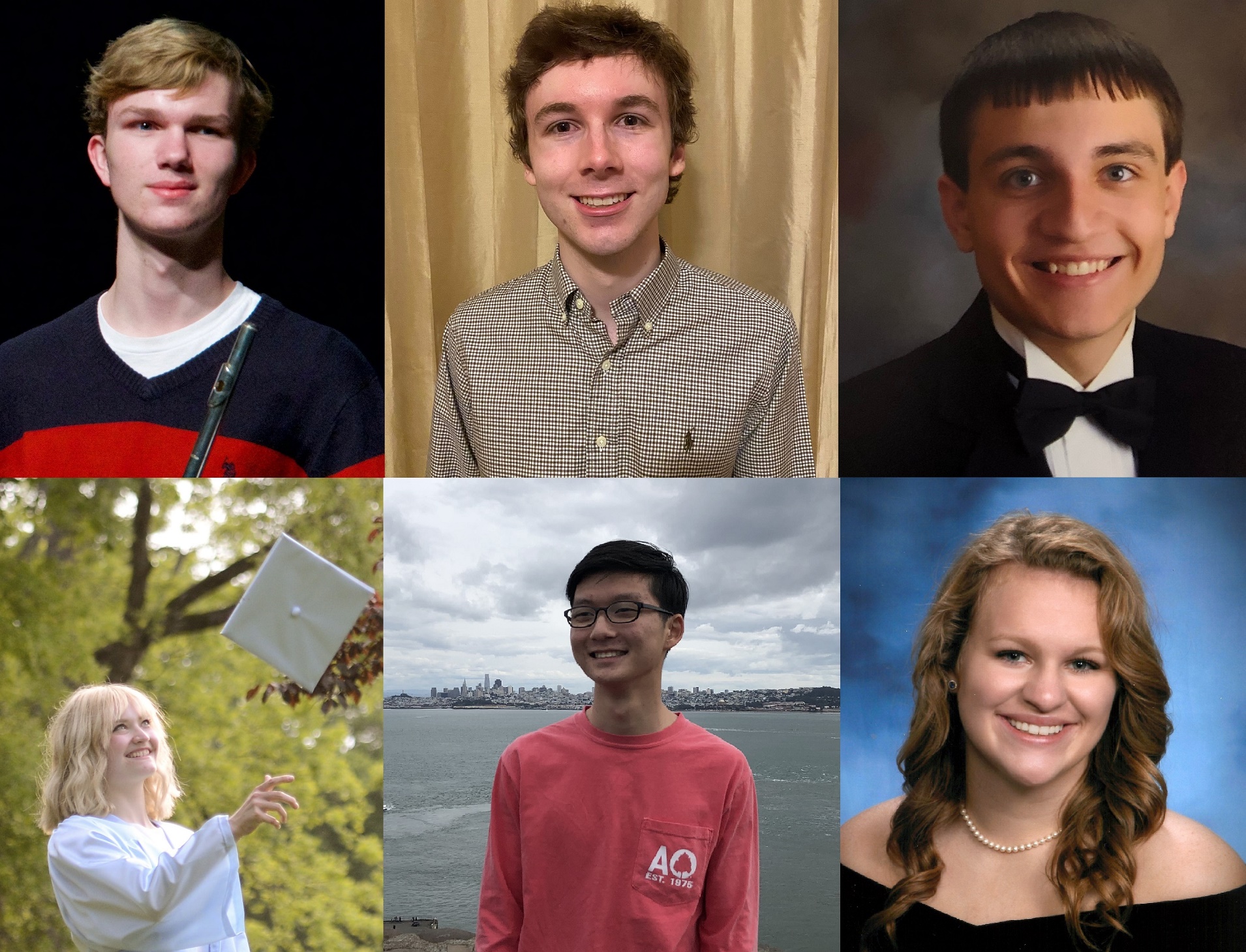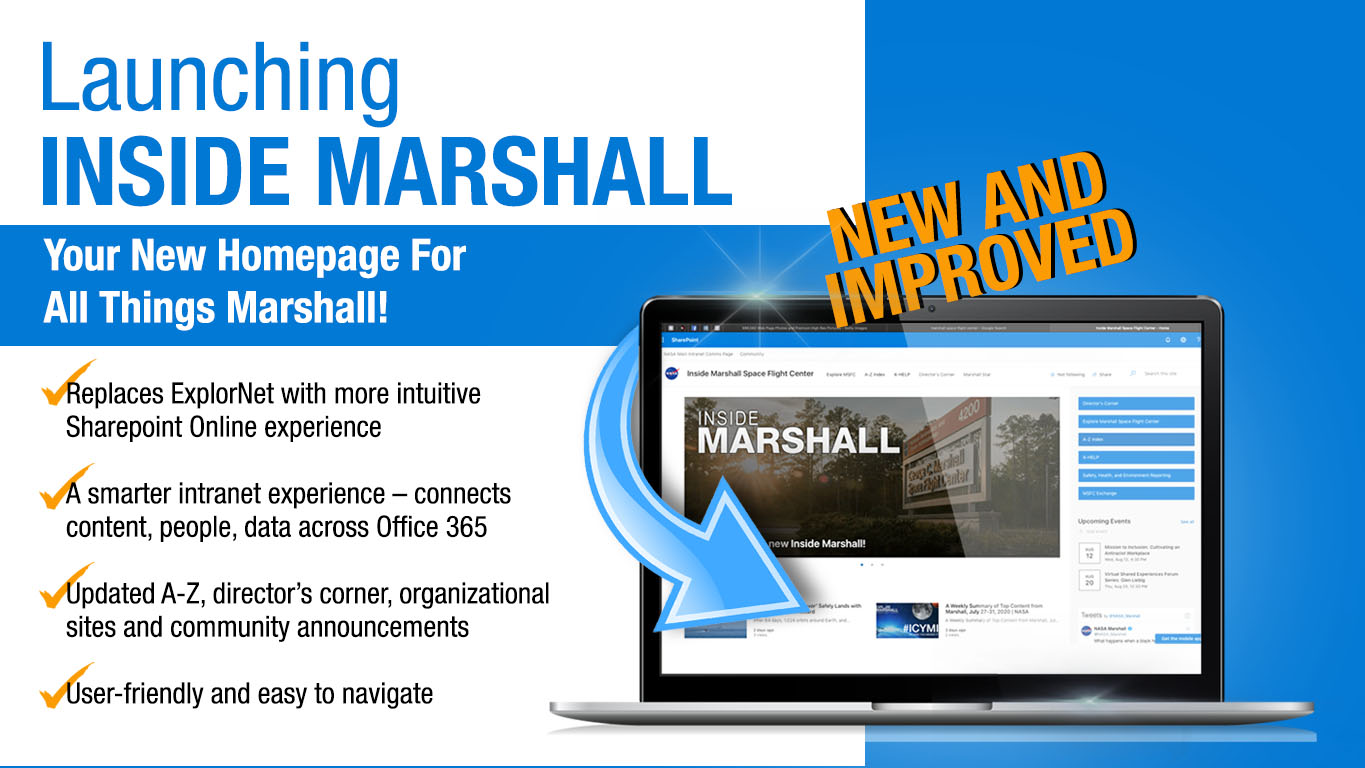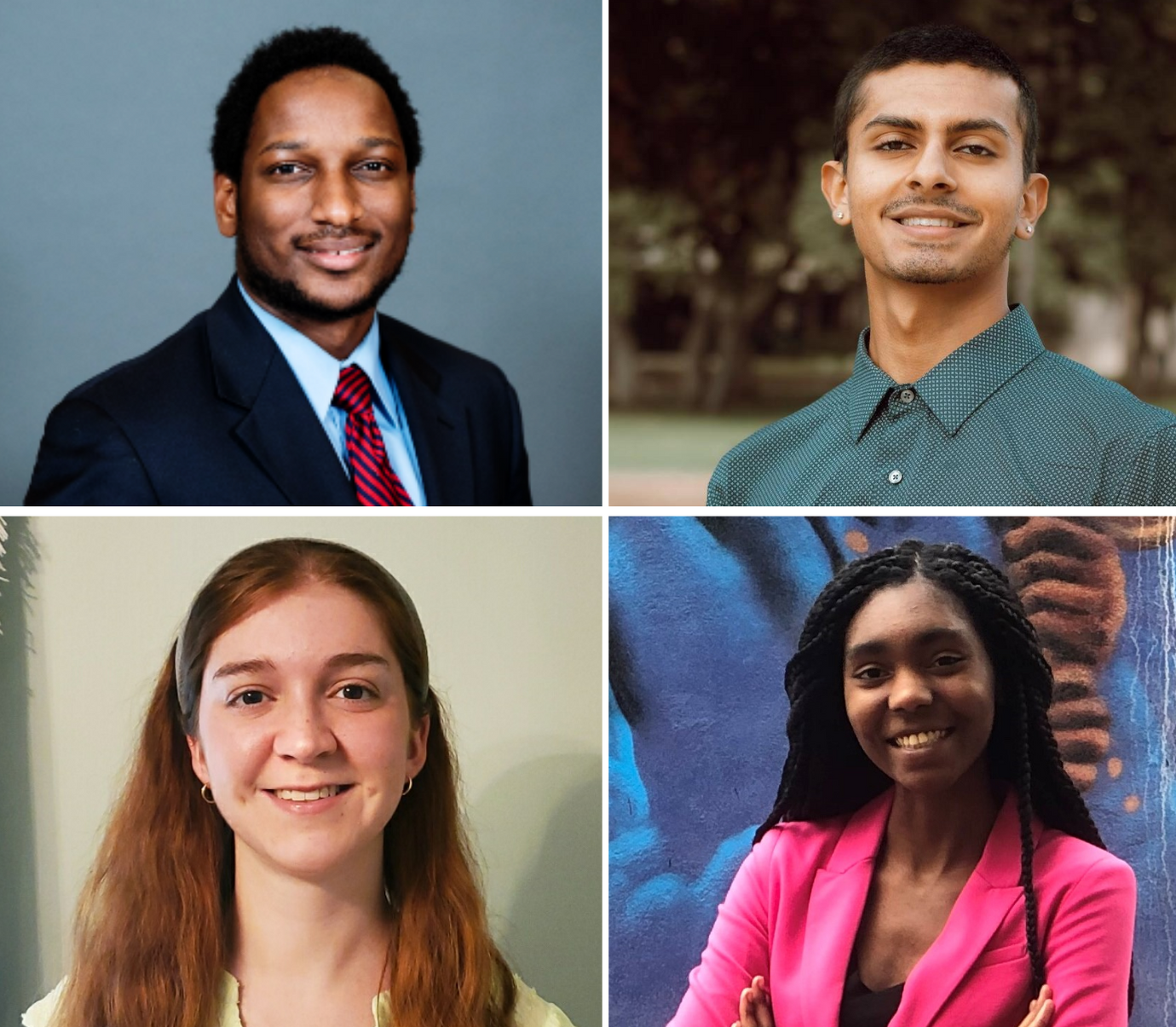In This Week’s Star
- Steven Wofford Named Manager of SLS Block 1B/Exploration Upper Stage Development Office
- Marshall Leaders Talk Pandemic Protocols in Latest Virtual Town Hall
- Take 5 with Deborah Crane
- NASA Awards Contract for Strategic Research and Analysis, Communications, Exhibits Services at Marshall
- Marshall Association to Present Annual Scholarships Aug. 20
- New Inside Marshall Intranet to Launch Sept. 9
- A Successful Mission: Marshall’s Summer Interns Go Virtual
- Planet Federal’s Tanya Harrison to Deliver Virtual Tech Talk
- NEA Scout, OSIRIS-Rex Highlighted on ‘This Week @NASA’
- This Week in NASA History: STS-105 Lands – August 22, 2001
Steven Wofford Named Manager of SLS Block 1B/Exploration Upper Stage Development Office
Steven Wofford, a 20-year veteran propulsion engineer and manager at NASA’s Marshall Space Flight Center, has been named manager of the Block 1B/Exploration Upper Stage Development Office at Marshall.
Wofford will oversee development of the advanced Block 1B configuration of the evolvable Space Launch System’s exploration upper stage – designed to loft a cargo fairing carrying heavy exploration systems, including the Orion spacecraft and a human-rated planetary landing system, to the Moon, Mars, and beyond. SLS is the only human-rated, heavy-lift rocket designed to launch Orion and send it on missions to the Moon. The Block 1B configuration can lift more than 81,571 pounds to space, including Orion and its Artemis Generation crew.
Wofford will manage the office’s budget, schedule and lead a combined workforce of civil servants, prime contractors, and support contractors. Additional support contractors and suppliers from around the nation will contribute to the development and flight of the Block 1B crew vehicle.
From 2014 to 2020, Wofford was manager of the SLS Program’s Liquid Engines Office at Marshall. From 2012 to 2014, he was deputy director of Marshall’s Safety and Mission Assurance Directorate, where he was responsible for overseeing safe execution of all center programs, projects, and institutional services. He was business manager for the Safety and Mission Assurance Directorate from 2011 to 2012.
From 2009 to 2011, Wofford was deputy manager of the Space Shuttle Main Engine Project Office at Marshall, helping to see the shuttle program to its successful conclusion in 2011. He was chief safety officer for the Safety and Mission Assurance Directorate from 2006 to 2009, formulating and communicating flight safety guidance and serving as Marshall’s safety technical authority on a wide gamut of propulsion technical issues.
In 2005 and 2006, he was lead designer and developer for engine component technologies supporting the Ares I and Ares V launch vehicles, next-generation rocket development programs that helped inform work resulting in the design, delivery, and manufacture of SLS engine systems.
Wofford began his NASA career in 2000 as a subsystem manager in Marshall’s Space Shuttle Main Engine Project Office. Before that, he supported the agency for more than 13 years as a contractor engineer, conducting assessment engineering and project integration engineering duties in support of the space shuttle main engine.
A Huntsville native, Wofford earned a bachelor’s degree in mechanical engineering in 1986 from the University of Alabama in Tuscaloosa, and a master’s degree in aerospace engineering in 1991 from the University of Alabama in Huntsville. His numerous career honors include a NASA Exceptional Achievement Medal in 2009 for his leadership in defining, implementing, and executing safety and mission assurance technical authority for the Space Shuttle Program. He also received a NASA Silver Snoopy Award in 1998, presented to team members who have made significant contributions to the human spaceflight program; and a Spaceflight Awareness Award in 1992 for his contributions as a contractor to the space shuttle main engine. In 2018, he was named a distinguished fellow of the University of Alabama in Tuscaloosa’s College of Engineering.
Wofford and his wife, Marisa, reside in Huntsville and have two sons.
SLS work at Marshall will ensure NASA’s success in landing the first woman and the next man on the Moon by 2024, initiating a sustained lunar presence, and enabling future missions to Mars. Learn more about NASA’s Artemis program and its full spectrum of exploration goals here.
Marshall Leaders Talk Pandemic Protocols in Latest Virtual Town Hall
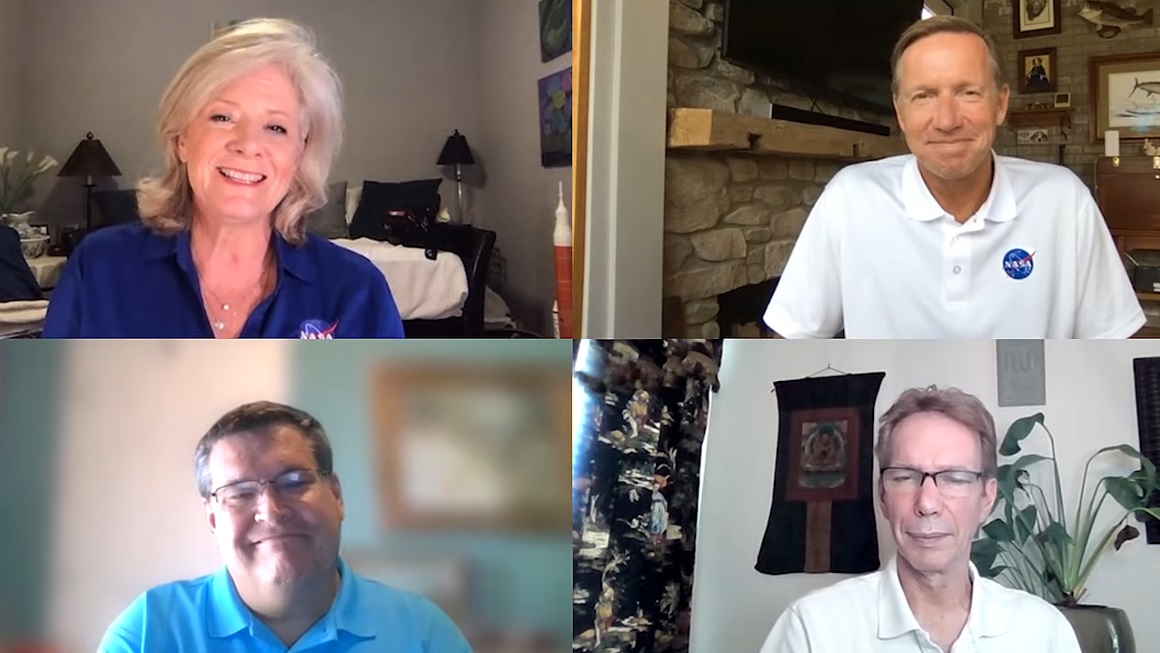
NASA’s Marshall Space Flight Center leaders – clockwise from upper left, Director Jody Singer; Associate Director Steve Miley; Deputy Director Paul McConnaughey; and Larry Leopard, director of Marshall’s Engineering Directorate – address team members during a virtual town hall Aug. 10. They provided updates on COVID-19 pandemic protocols, primarily Marshall’s transition from Stage 4 to Stage 3 of the NASA Framework for Return to On-Site Work, and took team members’ questions on a variety of subjects. “Moving to Stage 3 enables us to continue to make progress on our vital agency work at home and on-site at Marshall and Michoud Assembly Facility,” Singer said. “Most importantly, we want to do it safely and make sure your health remains at the forefront of our plan.” The complete town hall can be accessed via ExplorNet. To get the latest updates on the COVID-19 pandemic and NASA’s and Marshall’s response on Inside Marshall and NASA People. (NASA)
Take 5 with Deborah Crane
Growing up on a small farm in Shawnee, Kansas, Deborah Crane spent her days caring for animals, tending crops, and repairing anything in need. All the while, her dreams took her far from home – to NASA and space exploration.
Crane loved the arts and science, and was inspired by space exploration at an early age. As she got older, those dreams became something of a childhood fancy, and she instead pursued a career in dance. Crane moved to New York after her ballet talents earned her a scholarship to The Alvin Ailey Dance School. She returned to the Midwest to dance for the Westport Ballet Company in Kansas City, but a chance encounter with a friend provided a path to pursue a career in space exploration, and she headed west to earn bachelor and master degrees in mechanical engineering from the University of California, Berkeley.
Crane worked with United Space Alliance at NASA’s Kennedy Space Center in the Solid Rocket Booster Element Division’s analytical team before joining the agency’s Marshall Space Flight Center in 2007. In March 2019, she began her current role as launch vehicle chief engineer for NASA’s Commercial Crew Program.
Crane, who now lives on a 25-acre farm, met virtually with Marshall Star editor Daniel Boyette to discuss the Commercial Crew Program, the successful launch of NASA’s SpaceX Demo-2 mission, and farm life.
Question: How does the Commercial Crew Program encourage collaboration and integration?
Crane: We work with the engineering and management teams across not only our commercial partners, but across three NASA centers – Kennedy, Johnson, and Marshall. Collaboration and good communication are imperative. With three centers, we’re able to pull on and integrate their various and diverse technical expertise, and their perspectives that I think are necessary to make progress as we go through the process of human rating the commercial partners-provided launch systems for crewed missions.
We do that by encouraging open communication, having frequent tag ups, technical interchange meetings and engineering review boards, often with commercial partners. We have to accommodate four time zones. That is a challenge, but we have made it work. Before COVID-19, we would travel frequently to NASA centers and commercial partners to work hand in hand with the engineers on the team as well as program, commercial, and center management. One key to success in a fast-moving program like CCP is open discussion and a focus on communication so that we hear all the perspectives, we understand any concerns, assess and communicate any associated risks, and we determine a path to resolution.
Question: How does the Commercial Crew Program define and achieve mission success?
Crane: The goal of the CCP is to enable our commercial sector to develop rockets and spacecraft, so that we can launch and transport astronauts to the International Space Station. That’s our mission success. It’s very simple. We achieve mission success when we are able to do that safely, as we demonstrated with the Demo-2 launch.
Question: What was your Demo-2 launch day like, and what were your feelings as you watched the successful launch?
Crane: It was awesome! I had been in my role for just 15 months. We had all worked very hard – many long days, weekends, and holidays – to get to that launch day. We realized the importance of getting to that day and the need for NASA to provide that ability so that we can again launch crew from Kennedy and transport our astronauts to the International Space Station and ultimately beyond.
On launch day, there was an intensity as we went into the countdown, and yet, in my mind, I knew we had a great team of people, that we did the best job we could to prepare, and that I am very proud to be part of the historical Demo-2 milestone and the Commercial Crew Program. In the final count, I stood up from my console screens, and I had a big sigh of relief as I thought, “We did it!” Because of the facemask, nobody could see the huge smile on my face. There was such a beaming pride from the NASA and SpaceX teams. It was wonderful. Yet, I also knew that the launch was just the first part of the mission, and total success could not be declared until the Demo-2 astronauts, Bob Behnken and Doug Hurley, returned home safely.
Question: Who is someone that influenced your career, and how?
Crane: A long time ago, I met an engineer named Kelley Cramm and, to this day, she is a very dear friend. I met her while I was a member of the Westport Ballet Company in Kansas City. She was attending the jazz dance classes with the company and she inspired me to return to school to pursue a degree in mechanical engineering and I saw that as a path to NASA. When I was close to obtaining my degree goals, one of my older sisters asked me what I was going to do with my degree. I replied, “I want to work for NASA”. She asked me how I was going to do that. I said, “I really have no idea, but I will find a way.” The love I have for space science and exploration, the seed that Kelly set to pursue mechanical engineering, and the commitment and determination that I have to make NASA successful have all directed me . well, here I am with my dream come true!
Question: What did you learn growing up on a farm that helped you in your NASA career?
Crane: Living and working on a farm is all about prioritization, which is what I do as a chief engineer. At home on the farm I call it, “Farm Systems Engineering.” There is a definite analogy to what I do right now. New problems and challenges always come up and you often can’t always go to your plan. I have to figure out what needs to be addressed first, what are the risks to put something on hold and how to get something done with the people, other resources and the time that you have available. I am always determining a strategy to accomplish what is necessary and assessing what risks exist for alternate decisions and how that all fits into the big picture assessment, whether at home working on the farm or on the job.
Previous Take 5s
Angie Jackman, project manager for the Mars Ascent Vehicle
Rhega Gordon, Marshall’s chief financial officer
Robert Champion, director of Michoud Assembly Facility
Bill Marks, deputy director of Marshall’s Office of Center Operations
Katherine Van Hooser, Marshall’s chief engineer
Bobby Watkins, manager of the Human Exploration Development & Operations Office at Marshall
Neil Rodgers, director of the Office of the Chief Information Officer at Marshall
Lisa Watson-Morgan, manager of NASA’s Human Landing System Program
Mary Beth Koelbl, deputy director of Marshall’s Engineering Directorate
NASA Awards Contract for Strategic Research and Analysis, Communications, Exhibits Services at Marshall
NASA has awarded the Strategic Research and Analysis, Communications, and Exhibits Services contract at the agency’s Marshall Space Flight Center to Media Fusion LLC of Huntsville.
This is a firm-fixed-price contract with indefinite-delivery, indefinite-quantity task orders. The contract begins Oct. 1, with a one-year base period, followed by four one-year option periods. The maximum potential value of the contract, including all options, is approximately $57.5 million.
Marshall’s Office of Strategic Analysis & Communications has a continuing need for these services, which are key in implementing and maintaining an overarching communications strategy that clearly and consistently communicates NASA’s strategic vision and guidance, along with Marshall’s goals and business strategy, to both internal and external stakeholders. Services performed under this contract include support for the Office of Strategic Analysis & Communications and its customers, along with satisfying specific communications product-oriented requirements.
Marshall Association to Present Annual Scholarships Aug. 20
The Marshall Association will host its annual scholarship awards luncheon – virtually – on Aug. 20, presenting six exceptional student achievers, all children of team members at NASA’s Marshall Space Flight Center, with a total of $7,800 in scholarship funds.
Members of the Marshall team can watch the live event here Aug. 20 beginning at 11:30 a.m. CDT.
NASA astronaut Jasmin Moghbeli, a naval helicopter pilot and Marine Corps test pilot, and member of NASA’s 2017 astronaut class, will be the guest speaker. She will join Marshall Association President Reggie Alexander to present the virtual awards.
“In a year punctuated by a global pandemic and civil upheaval, our scholarship recipients face unique challenges as new collegians,” said Alexander, manager of Marshall’s Partnerships and Formulation Office. “The Marshall Association is proud to honor not just their hard work and creativity as they undertake this perennial rite of passage, but their zeal to help shape a better tomorrow for generations still to come.”
The scholarships will be awarded to qualifying, college-bound students who are children of association members and who are pursuing undergraduate studies in science, technology, engineering, and mathematics – the STEM fields – or associated, non-technical fields.
Recipients of $1,500 scholarships in STEM and non-STEM areas of excellence, respectively, are John Hedayat and Madison Werkheiser. Hedayat is the son of Marshall liquid propulsion systems engineer Ali Hedayat. Werkheiser is the daughter of Niki Werkheiser, program executive for NASA’s Game Changing Development Program, and Arthur Werkheiser, technical integration manager for cryogenic fluid management at NASA Headquarters.
Noah Kim, son of SERVIR project manager Tony Kim, and Ben Blankenship, son of Clay Blankenship, a University Space Research Association scientist at Marshall, each will receive $1,200 STEM-focused scholarships. Non-STEM awards of $1,200 each will be presented to John Broussard and Anna Kelley. Broussard is the son of Marshall flight systems test engineer Shawna Broussard. Kelley is the daughter of Stephanie Kelley, an Arctic Slope Regional Corporation contractor who serves as the contract’s creative director supporting the Office of Strategic Analysis & Communications.
Each applicant submitted an essay on the theme, “Visions for Today & Tomorrow” – which challenged them to consider the long-term impact of the nation’s current cultural upheaval and how they might lead future generations to a safer, better global future.
Annual scholarship eligibility requirements and further details can be found here.
Established to build the exchange of innovative and stimulating ideas within the Marshall community, the Marshall Association is a self-governing organization of dues-paying members, including NASA civil service employees, contractors, retirees, and community members.
Association members sponsor the annual scholarships, a monthly speaker program, and other networking and engagement activities. They also organize the popular Racin’ the Station duathlon typically held each September, in which participants strive to run and bike slightly more than 18 miles in less than 91 minutes, 12 seconds – the time required for the International Space Station to complete a full orbit of Earth. The race helps fund the association’s scholarship program.
Yearly association membership is $30. Those interested in registering can do so here.
New Inside Marshall Intranet to Launch Sept. 9
By Daniel Boyette
A new intranet era is coming to NASA’s Marshall Space Flight Center. After 10 years of using the ExplorNet application, Marshall will debut its new SharePoint Online-based intranet Sept. 9. The more intuitive platform will be team members’ home for all things Marshall – connecting content, people, and data across Office 365.
Inside Marshall will remain the central hub on the new intranet and become the default browser homepage for team members. The site will include a more user-friendly interface, the latest center news, events, and announcements, and continue to be home to numerous updated features, such as the A-Z index, Director’s Corner, 4-HELP, and the Marshall Star.
“At this challenging time when the majority of team members are working virtually, we are optimistic that the new Inside Marshall will become the go-to destination for employee information and news,” said June Malone, manager of Marshall’s Office of Communications, part of the Office of Strategic Analysis & Communications.
ExplorNet content has been transitioned into the new intranet or other collaboration spaces like Microsoft Teams. Instructions on transitioning to the new platform can be found on the ExplorNet Migration page. Users who have questions regarding the transition can also contact Wendy Sullivan, Chip Thigpen, Evan Dial, or Barbara Jo Webb of the Office of the Chief Information Officer.
The Office of the Chief Information Officer provided the new intranet platform and the technical buildout, while the Office of Strategic Analysis & Communications informed the content by using intranet best practices and results from the employee communications survey that was conducted earlier this year.
“As the first NASA center to go live with its SharePoint Online intranet, Marshall was given the opportunity to pioneer the platform as an intranet for the agency,” said Brian Powell, supervisor of the Workforce Enabling Applications in the Agency Applications Office at Marshall. “We’ll save resources by using an enterprise tool. I’m proud that our internal team took on this project and provided the center fantastic customer service.”
NASA Headquarters and the agency’s Goddard Space Flight Center and Ames Research Center are currently building out their SharePoint Online intranet.
The Space Launch System Program is among a number of Marshall-based programs, organizations, and groups that have completed their transition to the new intranet.
“Keeping team members connected is integral to the SLS mission,” said Ann Yelle, team lead for ASRC Federal/Analytical Services supporting SLS strategic communications. “The updated SLS site on Inside Marshall, with its improved layout and interface, better links workers to one another and to vital resources.”
Boyette, an ASRC Federal/Analytical Services employee and Marshall Star editor, supports the Office of Strategic Analysis & Communications.
A Successful Mission: Marshall’s Summer Interns Go Virtual
By Lauren Lambert and Emily Clay
The internship session at NASA’s Marshall Space Flight Center and Michoud Assembly Facility looked a little different this summer. The COVID-19 global pandemic restricted access to work facilities, and schools across the country went virtual.
But even with on-site work limited, Marshall and Michoud still employed 100 summer interns who were able to complete their projects via telework from the safety of their own homes. Facilitating a virtual internship experience was no easy task, but that did not stop internship coordinators Kelsey Bickett and Maria Meador-Phillips in Marshall’s Office of STEM Engagement from getting it done.
“Transitioning to virtual internships on the fly was a major team effort, and we are so grateful to everyone who has helped keep the program going strong during this time,” Bickett said. “Internships involve so many different roles working together – protective services, IT, communications, resource analysts, administrative assistants, and, of course, wonderful project mentors. Thanks to all of these NASA employees, 100 students were able to have a life-changing experience this summer.”
This summer’s Marshall and Michoud intern group ranged from high school students through doctoral candidates, representing 64 institutions from 30 states, plus Puerto Rico, and working in 27 branches across all mission directorates. Twenty-four interns were funded through the Minority Undergraduate Research and Education Project, while 14 were funded by their state’s Space Grant Consortium.
“The summer session was successful, and I hope that the students enjoyed it as well,” Meador-Phillips said. “We are very thankful to everyone involved for being patient and understanding as we worked through this process.”
NASA is supporting virtual internships this fall across all centers. Future intern sessions through NASA’s Office of STEM Engagement internships program are open for applicants here.
The Marshall Star interviewed four summer interns who worked in different organizations at Marshall to learn how their summer went, what work they accomplished and their plans for the future:
Darold Kelly Jr.
School: University of the District of Columbia
Major: Computer engineering
Interning with: Planning and Analysis Branch, International Space Station Payload Stowage
What are you working on this summer? My project uses robotic process automation driven by UiPath software in order to automate a very time-consuming and tedious, but necessary, part of the job of Stowage Note processing procedure. It is projected to save several hundred hours per year for the duration of the International Space Station Program (eight to 10-plus years). That accumulates to a savings of approximately $40,000 per year across the length of the program.
What are your plans after graduation? I plan to pursue a career in cybersecurity.
What has your experience working at NASA been like? My experience at NASA has been absolutely amazing! It is rare to find a healthy workplace that promotes my growth to the extent where I want to put my best foot forward.
Interesting fact: I recently started a nonprofit organization dedicated to increasing the number of Black cybersecurity professionals. So far, we have over 900 members and have already grown into the largest Black-owned cybersecurity organizations in the world!
Talha Khan
School: University of Texas at San Antonio
Major: Computer engineering
Interning with: Earth Science
What are you working on this summer? I’ve had the chance to join NASA’s IMPACT Earth Science Phenomena Detection team. NASA collects satellite imagery on a number of hazardous earth phenomena, such as tropical storms, dust storms, volcanoes, and more. Detecting these kinds of hazardous events before their onset can be critical to mitigating the economic damages that come and can even save lives. Using satellite imagery, I’m creating a deep learning artificial intelligence model to automate the detection of dust storms in real time in order to alert weather forecasters, emergency managers, and citizens.
What are your plans after graduation? I plan to enter the industry and work as a deep learning engineer and also apply for a doctorate program in computer science and artificial intelligence. I’ve always wanted to be a leader. My dream career is to lead an organization like NASA or Google and to shape the agendas that will change the world of tomorrow. Even more so, I hope to someday create a startup of my own that can optimize the quality of life we hold today.
What has your experience working at NASA been like? Working at NASA has been absolutely incredible. Even as a virtual intern, I can feel the camaraderie, friendship, and family-like bond that everyone at NASA holds. When the mission scale is to reach the impossible, the most talented and brave individuals reveal themselves to the world. NASA’s community, outreach, and presence is filled with so much talent that it’s truly inspiring and humbling to be a part of the organization. I feel like I learn something new every day.
Interesting fact: I’m 6 feet, 7 inches tall; I used to want to play in the NBA!
Ruthie Hill
School: University of South Alabama
Major: Mechanical engineering
Interning with: Advanced Concepts Office
What are you working on this summer? I am organizing, analyzing, and assessing studies and projects completed in the Advanced Concepts Office. I compiled all the hardware used in an ACO study into an Excel workbook and organized it by its Technology Readiness Level and mechanical properties. Then, I researched other hardware on the market to compare to the selected components to see if there are more advanced options available that better suit the study objectives. Additionally, I updated the Human Lunar Exploration Spacecraft Summary Index, which is a large PowerPoint document that summarizes ACO Lunar Studies dating back to 1961. I created a summary of each recent lunar project and found trends in propulsion system data for each study.
What are your plans after graduation? I plan to pursue my master’s degree in aerospace engineering and to apply for a Pathways internship after I graduate. I wish to continue my career with NASA, hopefully testing and assembling hardware that will help take the first woman and the next man to the Moon and beyond.
What has your experience working at NASA been like? It has been nothing like I expected! I never imagined how nice and understanding everyone at NASA would be. I was initially intimidated by the vast amount of knowledge available to everyone at NASA because I thought my lack of experience would hinder me. But I have found that everyone here is encouraging and wants to see growth and development in everyone. I have learned something new every day, sometimes from my mentors and other interns, or sometimes from the many lectures available during lunchtime. I have enjoyed every moment of my internship and I hope to keep working for NASA in the future!
Extra credit: Music is my main hobby and I love to play piano, ukulele, and lots of percussion instruments! Drum set is my favorite, though, and I used to be the drummer for a band when I was in high school.
Morghan Graper
School: Albany State University in Georgia
Major: Mathematics
Interning with: Engineering Resources Management Office
What are you working on this summer? This summer, my fellow intern and I are working with Kisha Freed, Project and Engineering Collaborative Environment Project coordinator. Our project is examining and illustrating the collaborative environments within the engineering communities of practice. We are assessing the nature and likelihood of the teams to collaborate with one another, and illustrating that through diagrams and metrics. We are also promoting best practices for leaders and administrators to utilize for more effective collaboration.
What are your plans after graduation? As I just graduated in May, I have been looking into different fields to use my mathematics degree. Because of my love for working with numbers, my dream career would be working as a financial manager. Being a financial manager would allow me to express my two passions at once: working with numbers and helping people. It is also important for me to work for a company with great energy in the workplace, where my colleagues love their careers as much as I do.
What has your experience working at NASA been like? My experience at NASA has been amazing. I have been learning how to apply my technical skills to a project, as well as sharpening my communication skills to effectively work with my team. I have also learned a lot about myself during this internship. I have realized the strengths I have that make me an asset to a team, and what skills I need to work on. It has truly given me insight on what having a career would be like, and I will always be grateful to this internship for giving me that.
Extra credit: I’m left-handed. And, if I could have any superpower, it would be to fly.
Lambert and Clay, both NASA interns, are supporting the Office of Strategic Analysis & Communications this summer.
Planet Federal’s Tanya Harrison to Deliver Virtual Tech Talk
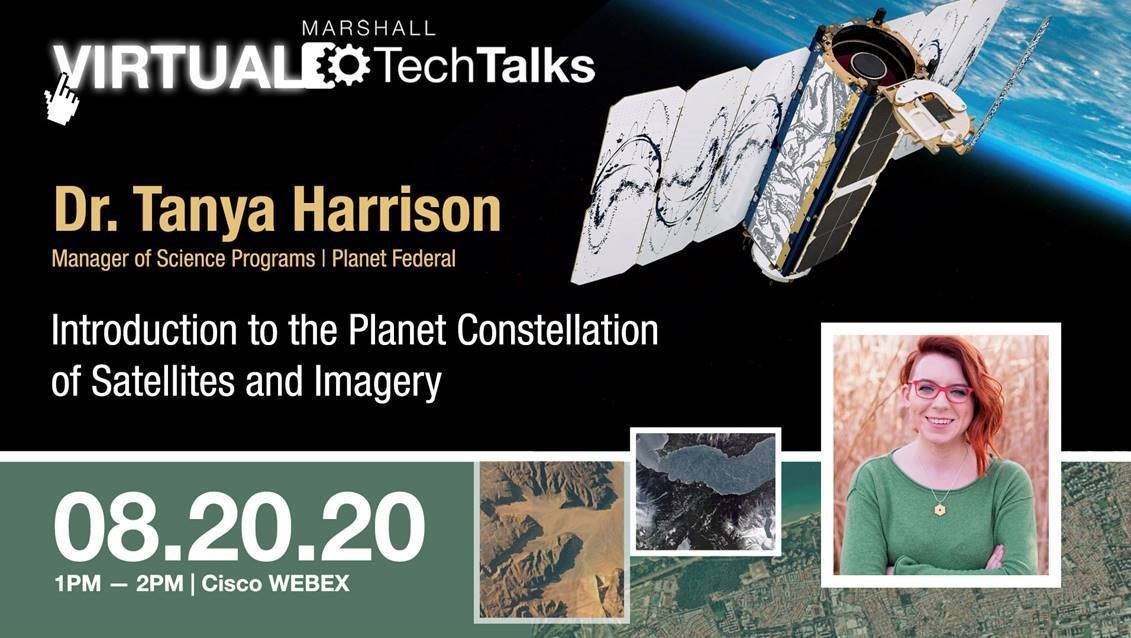
Tanya Harrison, manager of science programs for Planet Federal in Washington, will virtually present the latest installment of NASA’s Marshall Space Flight Center’s Tech Talk series at 1 p.m. Aug. 20. Harrison will give an overview of Planet Federal’s satellite constellations and image data products, along with highlights of applications for the imagery. NASA has an agreement that provides all agency-funded researchers access to imagery from Planet Federal’s PlanetScope satellite constellation. The talk will be streamed via Webex; login information can be found here. The Tech Talk series is presented by the Marshall Center Chief Technologist’s Office. This month’s talk is co-sponsored by Marshall’s Office of the Chief Scientist. (NASA)
NEA Scout, OSIRIS-Rex Highlighted on ‘This Week @NASA’
NASA’s NEA Scout CubeSat and OSIRIS-Rex mission are featured in “This Week @NASA,” a weekly video program broadcast on NASA-TV and posted online.
NEA Scout, which will use huge solar sail for propulsion, will travel and study a near-Earth asteroid. The innovative CubeSat is among the payloads that will launch on Artemis I. NEA Scout’s solar sail is being developed at NASA’s Marshall Space Flight Center.
On Aug. 11, OSIRIS-REx performed its final practice run of the sampling sequence at asteroid Bennu. The rehearsal confirmed that the team and all of the spacecraft’s systems are ready to collect a sample in October. OSIRIS-REx is the third mission in NASA’s New Frontiers Program, which is managed by Marshall for the agency’s Science Mission Directorate.
View this and previous episodes at “This Week @NASA” on NASA’s YouTube page.
This Week in NASA History: STS-105 Lands – August 22, 2001
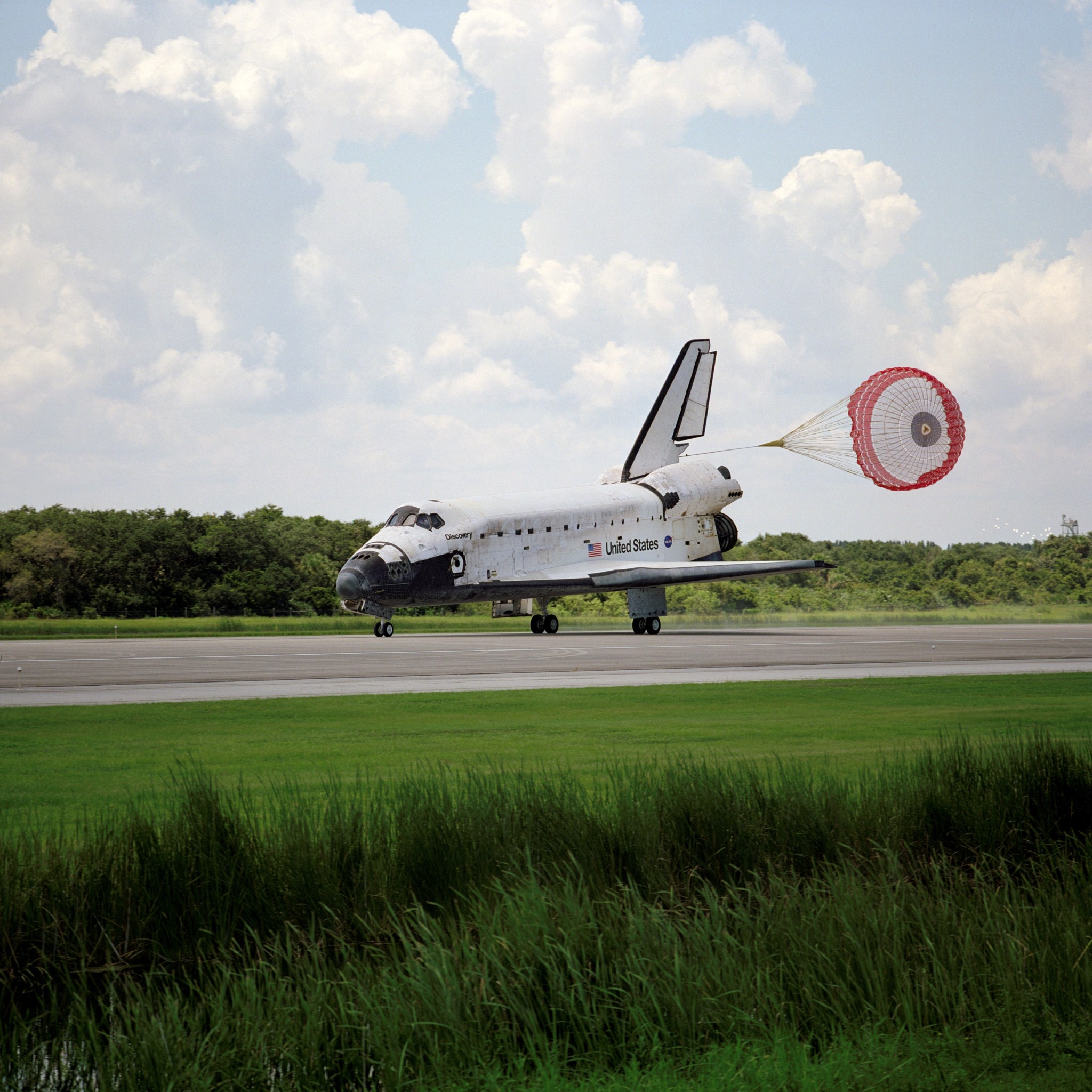
This week in 2001, space shuttle Discovery, mission STS-105, landed at NASA’s Kennedy Space Center following a successful 11-day mission to the International Space Station. Discovery’s payload included the Early Ammonia Servicer, which was installed on the outside of the station, and 7,000 pounds of supplies, equipment, and science racks stored in the Multi-Purpose Logistics Module Leonardo. This was the second flight of Leonardo to the orbiting lab. The Multi-Purpose Logistics Modules were built by the Italian Space Agency and managed by NASA’s Marshall Space Flight Center. The NASA History Program is responsible for generating, disseminating, and preserving NASA’s remarkable history and providing a comprehensive understanding of the institutional, cultural, social, political, economic, technological, and scientific aspects of NASA’s activities in aeronautics and space. For more pictures like this one and to connect to NASA’s history, visit the Marshall History Program’s webpage. (NASA)
























